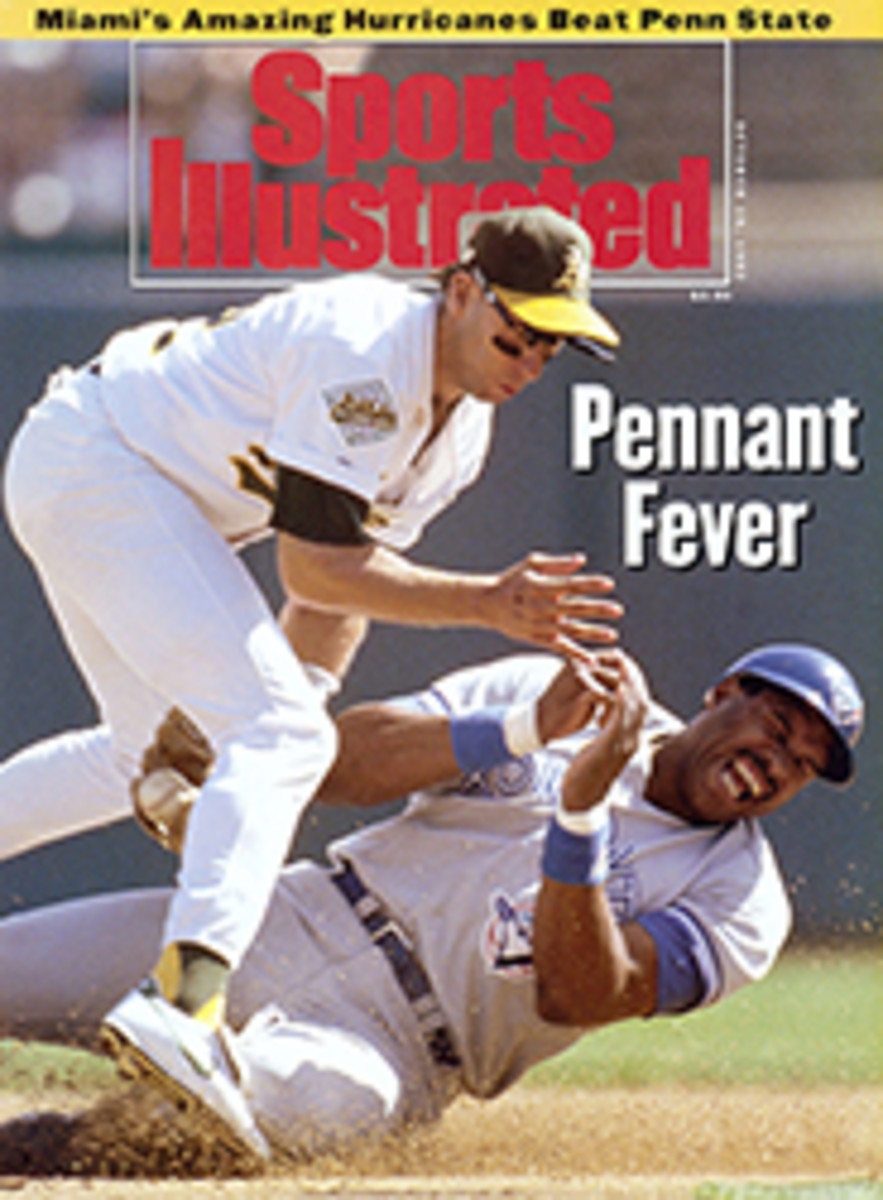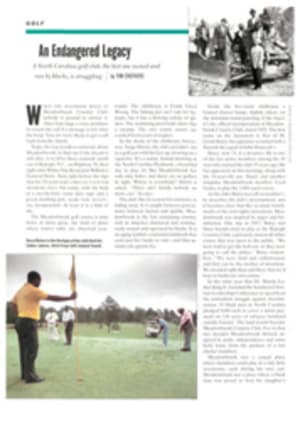
The Pigskin Brings Home the Bacon
Can anyone here kick a field goal? wonders Hartwick College football coach Steve Stetson. It is late August. Hartwick has had 42 years to prepare for its Sept. 12 season opener with King's College, and Stetson still has no placekicker.
He did have Chris Weeks, a soccer-style specialist, who had been doing a terrific job of demonstrating why he was not on the soccer team. Then one day Weeks attempted a placekick and drove his toe into the turf instead. He wound up going to the hospital for emergency surgery on his shin.
Funny thing about the Warriors' field goal follies. Hartwick is in Oneonta, N.Y., you see, and if there's one thing that folks there know how to do, it's kick a ball. Oneonta is Soccertown, U.S.A. It is a community of 15,000 in which the youth soccer leagues can count 1,600 participants. The National Soccer Hall of Fame is just a corner kick off Main Street. "The difference between Oneonta and the rest of the country," says Hartwick's president, Richard Detweiler, "is that here soccer is part of Americana."
Hartwick itself, a private liberal arts college of 1,498 students, is a soccer leviathan. Under the guidance of coach Jim Lennox, who has become something of a legend, the Warriors have made the NCAA Division I semifinals six times in the last 18 years, winning the national championship in 1977. Forty-seven Warriors have entered the pro ranks, and last year's team captain, Mike Burns, also played on the U.S. Olympic team in Barcelona. And Burns wasn't even Hartwick's best player last fall.
"Paul Conway was," says Graham Starr, a senior on the basketball team, "but Coach Lennox had to kick him off the team because he would berate his teammates when they messed up. Conway was a disruptive force."
Conway was a light breeze compared to the typhoon that swept over the campus when talk of reinstating football began. After thrashing Clarkson Tech 20-0 on Nov. 10, 1950, Hartwick announced that it was discontinuing football "for an indefinite period," because of an expected shortage of men. In 1990, when it announced it would consider reinstating football for the same reason—this time the goal was to attract men—the campus erupted.
Hartwick's board of trustees first met in May 1990 to discuss reviving the football program. Arriving at their meeting, the trustees were alarmed to find 50 students waiting to talk to them. One protester, Paul Harrison, now a senior, explains, "I hate football." Says Burns, who chose Hartwick over big-name Virginia, "I love how soccer is Number One here."
Like many small private colleges, Hartwick is at war against a declining enrollment, and male application figures are particularly low. Two years ago Philip Wilder, then Hartwick's president, began casting about for ways to make the school more attractive to men. Apparently the 60-40 female-to-male ratio was not enough of a lure.
Wilder heard plenty of suggestions. How about a Latin American studies program? An environmental-studies major? Semester abroad? And then, football. "Once it was suggested, football jumped, jumped, to the top of the list," says athletic director Ken Kutler.
The man who first suggested that pigskin might bring home the bacon for Hartwick was the school's vice-president for finance, John Pontius. Wilder immediately warmed to Pontius's proposal. What both men underestimated was just how many proud Warriors resided on the hillside campus. Sixty-seven percent of the faculty voted against football when the subject was first broached, and 78% of the student body nixed the idea as well.
Pontius nevertheless did his homework. The board convened a committee to study football's feasibility, and Pontius supplied it with reams of material to study. His 19-page financial analysis entitled "Football at Hartwick?" asserted that if the school enrolled 91 additional students (i.e., football players) in the program's first four years, Hartwick would profit by nearly $800,000.
For more than a year the board of trustees considered the arguments against the proposal: Football is too expensive; football players, who are unruly and dumb, will tarnish the school's reputation; and, finally, Hartwick has soccer, it doesn't need football. The board listened, and the board held discussions. Then, on July 12, 1991, when faculty and students were on summer break, the board reconvened and voted to reinstate football.
Stetson was a disgruntled health-insurance salesman in July 1991 when he announced to his family and friends that it was time for him to return to coaching football. His last job, as head coach at Boston University, had ended in 1987 on a sour note. He was fired after the Terriers went 3-8 for the season.
A week after his declaration, Stetson found a newspaper clipping that had been passed through the mail slot of his front door. The headline read HARTWICK TO REINSTATE COLLEGE FOOTBALL. Seven weeks later Stetson was selling high school seniors on Hartwick football.
"You never know what tomorrow will bring," says Stetson. One of his tomorrows brought 22-year-old freshman Sasha Anisimov, who last wore a uniform for the Red Army. He had not played a down of football in the United States, but Anisimov, a native of Fryzino, Russia, is 6'3" and 240 pounds. He bench-presses 400 pounds, and on this late August afternoon while Stetson is wondering who will put the foot into his football program, he announces that he has a knack for kicking field goals. Stetson chuckles and says, "All right, Russian, let's see what you can do."
Stetson's good humor and let's-see-what-we-can-do attitude has served him well since he was hired a year ago to build a team from scratch. How, for example, did he sell recruits on a football program that did not yet exist? "That's a good question," he admits. Or deal with the animosity of faculty and students? Stetson's face expands in a grin. "One faculty member stood up in a meeting and confided his fear that Hartwick was going to turn into a football factory."
What Stetson did in the 12 months leading up to the opener was assemble the most charmingly eclectic cast of characters since Spock and company manned the USS Enterprise. Take, for example, Billy Mottl, a wide receiver. When he heard that football was coming back to Hartwick, Mottl quit his job at the Camp Georgetown Correctional Facility in upstate New York and enrolled as a sociology major. Mottl, 36, is seven months older than Joe Montana, and Stetson says he's the first recruit with whom he has ever had a beer.
Shon Dellinger claims that he was among the five fastest players on the 1991 Buckeye football team. Yes, Ohio State. Dellinger, a walk-on, transferred to Hartwick after meeting an Oneonta lass in an Orlando bar following last year's Hall of Fame Bowl. "We're getting married on the 19th of June," says Dellinger, the starting H-back.
Not even Dellinger looks as good in football pads as Anisimov, who has lived in the United States for only 15 months. Anisimov has the body and the speed, if not the experience, of a Division I player. "I play leetle for factory team in Russia," he says, "but I learn things new every day here."
That may surprise his classmates. Mention Stetson's recruits to a Hartwick student, and you're likely to get a mime of a gorilla. That's not fair, nor is it accurate. Anisimov is fluent in English after only one year and is now tackling French as well as defensive tackle. Dellinger, a premed student, plans on sticking with football only so long as he can maintain his 3.8 GPA. Right guard Jim Cancellari was a national finalist in High School Challenge, a sort of prep Jeopardy. These three, like all Hartwick football players, attend not one but two mandatory study halls daily.
"Whether you believe it or not," Kutler told the team, referring to the dumb-jock slurs, "this year you are living in glass houses." But it's the team that has a right to throw stones. The average SAT score for incoming freshmen at Hartwick this year is 981. The 61 freshmen who came to play football average 995.
"Your soccer ball's all out of shape."
It is a Friday afternoon, the day before the Warriors' opening game, against King's College of Wilkes-Barre, Pa. Lennox, who is genuinely pleased with the advent of football at Hartwick, is kidding Stetson about the football he cradles in his right arm. The next afternoon Lennox's soccer team will defeat Fresno State 1-0. In the evening Stetson's Warriors will surrender a fourth-and-goal touchdown with :24 remaining and lose to King's College by the score of 20-17. Mottl will make the best catch of the game, and Anisimov will hit a 31-yard field goal, two PATs and quite a few of King's offensive backs. Afterward Stetson will have to explain to a newfound legion of fans why Anisimov is not in the offensive backfield himself. The Rushin' Russian. Stetson smiles.
"In 1991 we had 363 freshman," says Hartwick public relations director Bill Brophy, "and were told that we'd need to bring in a class of 415 in '92 to meet our budget. Was football a good idea? This year we have 453 freshman."
On Sept. 12 it seemed as if every one of them attended both the soccer and the football games. Oneonta may be a small town, but as Lennox and Stetson will tell you, it's big enough for both of them.
PHOTO
JOHN D. HANLON
At soccer-crazy Hartwick, a ballcarrier like Tom Tucker is definitely a fish out of water.
PHOTO
JOHN D. HANLON
Stetson sold insurance; now he sells Hartwick football.
PHOTO
JOHN D. HANLON
Anisimov, formerly of the Red Army, is tackling English and football simultaneously.
PHOTO
JOHN D. HANLON
Mottl quit his prison job to play.

